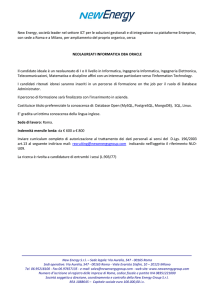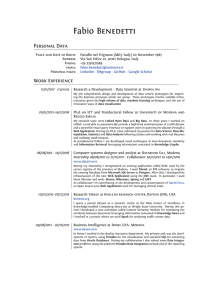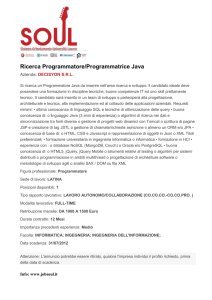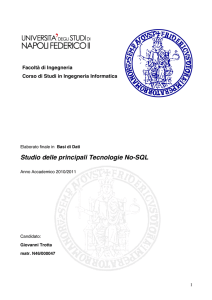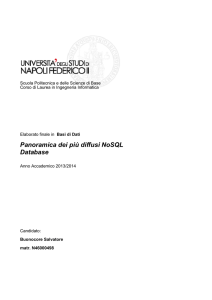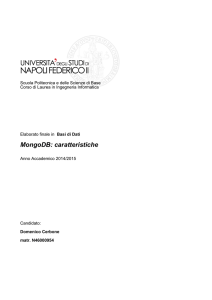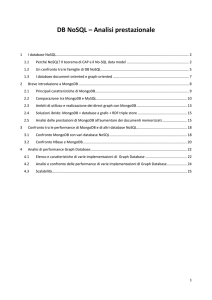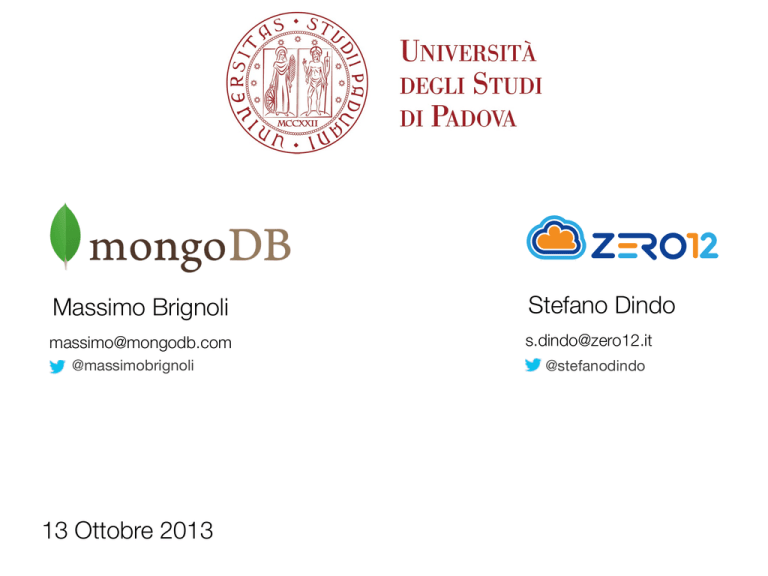
Massimo Brignoli
Stefano Dindo
[email protected]
[email protected]
@massimobrignoli
13 Ottobre 2013
@stefanodindo
Cos’è MongoDB ?
Database NOSQL document oriented
Si propone come soluzione al problema della quantità di informazioni: è un
sistema che si adatta meglio alla crescita consistente delle dimensioni degli
archivi, elaborandoli in poco tempo.
Benefici del modello a documenti
Agilità & Flessibilità
• Evoluzione semplice del modello di dati
• Adattamento e cambi rapidi sulla struttura dati
Rappresentazione dati intuitiva e naturale
• Sviluppatori sono più produttivi
• Le applicazioni risultano più semplici da gestire
Riduzione di operazioni di join e disk seek
• La programmazione è più semplice
• Maggiori performance
Introduzione … dai concetti base alle prime query
Terminologia
SQL - Like
Corrispettivo in MongoDB
Database
Database
Tabella
Collection
Riga
Document
Colonna
Field
Cos’è un documento per MongoDB?
Un documento è una struttura dati in stile JSON formata da
un numero variabile di coppie campo - valore
{
}
“nome”: “Giorgio”,
“cognome”: “Rossi”,
“email”: “[email protected]”,
“cell”: 3281432896,
“sport”: [“nuoto”, “calcio”]
MongoDB salva i documenti su disco in formato BSON (http://
bsonspec.org).
La dimensione massima di un documento BSON è 16MB.
MongoDB: Modello a Documenti
{
_id: ‘Objectid(“4b2b9…”)’,
first_name: ‘Paul’,
surname: ‘Miller’,
city: ‘London’,
location: [45.123,47.232],
cars: [
{ model: ‘Bentley’,
year: 1973,
value: 100000, … },
{ model: ‘Rolls Royce’,
year: 1965,
value: 330000, … }
]
}
Esempio
Documento
{
_id: ‘Objectid(“4b2b9…”)’,
first_name: ‘Paul’,
surname: ‘Miller’,
city: ‘London’,
location: [45.123,47.232],
cars: [
{ model: ‘Bentley’,
year: 1973,
value: 100000, … },
{ model: ‘Rolls Royce’,
year: 1965,
value: 330000, … }
]
}
Tipi di dati
Null
{ x: null }
Boolean
{ x: true }
Number
{ x: 3.14 } { x: 3 }
String
{ x: “zero12” }
Date
{ x: new Date() }
Array
{ x: [“a”,”b”, “c”] }
Embedded documents
{ x: {y: “a” } }
Object id
0
1
2
Timestamp
3
4
5
6
Machine
7
8
PID
9
10
11
Increment
Terminologia
Mongod:
E’ il processo server che esegue il database e che rende disponibile tutti i servizi
per la creazione di database, collections, l’inserimento di documenti e le relative
funzioni di interrogazione
Mongos:
E’ il servizio di routing per processare le query provenienti dallo strato applicativo e
che determina la locazione dei dati richiesti in una configurazione Sharding.
Mongo:
Rappresenta l’eseguibile per avviare la shell Javascript per interagire con database,
collezioni e documenti che possono essere interrogati e manipolati da riga di comando.
MongoDB shell
MongoDB dispone nativamente di una shell javascript per
l’amministrazione del database
172.31.21.36:27017
mongo 172.31.21.36:27017/firstDB
firstDB
mongod
Principali Comandi:
use <nome db>
show collections
db.<nomeCollection>.insert({…})
db.<nomeCollection>.findOne()
db.<nomeCollection>.update(<criterio>, {…})
db.<nomeCollection>.remove(<criterio>, {…})
Query
db.<nomeCollection>.insert(
<Documenti o array di Documenti>,
{
writeConcern: <document>,
ordered:<boolean>
}
)
db.testcollection.insert({item: “card”, qty: 15})
output: WriteResult({“Inserted”: 1})
find({…})
db.<nomeCollection>.find({<criterio>},{return key})
productsold
{
custom_id: “A123”,
amount: 500,
status: “A”
}
db.productsold.find({status: “D”})
{
custom_id: “A123”,
amount: 250,
status: “A”
}
{
custom_id: “A123”,
amount: 300,
status: “D”
{
custom_id: “B212”,
amount: 200,
status: “A”
}
{
custom_id: “A123”,
amount: 300,
status: “D”
}
}
find({…})
db.<nomeCollection>.find({<criterio>},{return key})
productsold
{
custom_id: “A123”,
amount: 500,
status: “A”
}
db.productsold.find({status: “D”}, {customer_id: 1, amount: 1 })
{
custom_id: “A123”,
amount: 250,
status: “A”
}
{
{
custom_id: “B212”,
amount: 200,
status: “A”
}
{
custom_id: “A123”,
amount: 300,
status: “D”
}
custom_id: “A123”,
amount: 300
}
Alcuni operatori per query condizionali
$lt: <
$lte: <=
$gt: >
$gte: >=
$or
productsold
{
custom_id: “A123”,
amount: 500,
status: “A”
}
{
db.productsold.find(
{amount: {“$gte”: 200,“$lte”: 250 }})
custom_id: “A123”,
amount: 250,
status: “A”
}
{
custom_id: “A123”,
amount: 250,
status: “A”
{
custom_id: “B212”,
amount: 200,
status: “A”
}
}
{
{
custom_id: “A123”,
amount: 300,
status: “D”
}
custom_id: “B212”,
amount: 200,
status: “A”
}
Altri operatori per query
Es. operatori logici
$and: {$and: [{<espressione1},{<espressione1}, …]}
$or: {$or: [{<espressione1},{<espressione1}, …]}
Es. Element
$exists: {field: {$exists: <boolean>}}
Es. Array
$all: {field: {$all: [<value>, <value>]}}
$elemMatch: {field: {$elemMatch: [<q1>, <q2>, …]}}
Query su embedded document
{
_id: ‘Objectid(“c75r4bb6…”)’,
name: {
first: ‘Stefano’
last: ‘Dindo’},
age: 30
}
db.user.find({name.first: “Stefano”, name.last: “Dindo”})
db.<nomeCollection>.update(
<query>,
<update>,
{
upsert: <document>,
multi:<boolean>,
writeConcern: <document>
}
)
db.testcollection.update({item: “card”}, {$inc: {qty: 6}})
output: WriteResult({“Matched”: 1,”Upserted”:1,
“Modified”: 1})
db.testcollection.update({item: “card”}, {“txt”: “Ciao”})
output: WriteResult({“Matched”: 1,”Upserted”:0,
“Modified”: 1})
ATTENZIONE USARE COMANDO
$SET
db.testcollection.update({item: “card”}, {$set: {“txt”:
“Ciao”}})
db.<nomeCollection>.remove(
<query>,
{
justone: <boolean>,
writeConcern: <document>
}
)
db.testcollection.remove({item: “card”})
output: WriteResult({“Removed”: 1)
GridFS
Cos’è ?
E’ un insieme di specifiche per salvare files su
MongoDB la cui dimensione eccede i 16MB
Si possono salvare SOLO files, ovvero
stream di byte
Come funziona
MongoDB divide il file in chunk e salva i chunks come
documenti separati.
Al momento del salvataggio del file, vengono popolate due
collections, la collection fs.chunks e la collection fs.files
{
"_id" : <ObjectId>,
"length" : <num>,
"chunkSize" : <num>,
"uploadDate" : <timestamp>,
"md5" : <hash>,
"filename" : <string>,
"contentType" : <string>,
"aliases" : <string array>,
"metadata" : <dataObject>,
{
"_id" : <ObjectId>,
"files_id" : <ObjectId>,
"n" : <num>,
"data" : <binary>
}
}
fs.chunks
fs.files
Come usarlo
1. Attraverso un driver
2. Uso dell’utility mongofiles
- mongofiles <options> <commands> <filename>
list
search
put
get
delete
Architetture
Perchè replica dei dati
• Quanto punti di failure vuoi avere?
• Quanti sonni tranquilli vuoi dormire?
• Mai avuto problemi di connettività?
• Più nodi facilitano l’uso dei dati in modo diverso
Replica Set
Creazione ReplicaSet
Nodo 1
Nodo 2
Nodo 3
Configurazione ReplicaSet - 1 di 2
1
Definire il nome del ReplicaSet (es. zero12rs)
2
Avviare mongodb con l’opzione ReplicaSet nel 1° nodo
$mongod --replSet zero12rs -f mongod.conf --fork
3
Avviare mongodb con l’opzione ReplicaSet nel 2° nodo
$mongod --replSet zero12rs -f mongod.conf --fork
4
Avviare mongodb con l’opzione ReplicaSet nel 3° nodo
$mongod --replSet zero12rs -f mongod.conf --fork
4
Eseguire la configurazione effettiva dei nodi replicaSet
Configurazione ReplicaSet - 2 di 2
> conf = {
_id : "zero12rs”,
members : [
{_id : 0, host : "A”},
{_id : 1, host : "B"},
{_id : 2, host : "C”},
]
}
> rs.initiate(conf)
ReplicaSet - 1 di 3
Nodo 1
Secondary
Nodo 2
Secondary
Heartbeat
Replica
Replica
Nodo 3
Primary
ReplicaSet - 2 di 3
Nodo 1
Secondary
Elezione primary
X
Nodo 3
Primary
FAIL !
Nodo 2
Secondary
ReplicaSet - 3 di 3
Heartbeat
Nodo 1
Primary
Nodo 2
Secondary
Replica
X
Nodo 3
Primary
FAIL !
Come funziona la replica
Come funziona la replica ?
oplog: contiene la lista di tutte le operazioni di scrittura e aggiornamenti fatti nel nodo primario
Primary
6
7
8
9
10
Secondary #1
6
12
13
query per oplogs {$gt: 10}
7
Secondary #2
6
11
8
9
10
query per oplogs {$gt: 7}
7
Sharding
Shard
Shard key
range
Elementi necessari per creare uno sharding
Mongod:
E’ il processo server che esegue il database e che rende disponibile tutte i servizi
per la creazione di database, collections, l’inserimento di documenti e le relative
funzioni di interrogazione
Mongos:
E’ il servizio di routing per processare le query provenienti dallo strato applicativo e che
determina la locazione dei dati richiesti in una configurazione Sharding.
Config Server:
Rappresenta i server contenenti i metadati relativi alle chiavi di sharding e alla
distribuzione delle informazioni.
Mongo:
Rappresenta l’eseguibile per avviare la shell Javascript per interagire con database,
collezioni e documenti che possono essere interrogati e manipolati da riga di comando.
Distribuzione dei dati
( Sharding )
Shard
Mongod
Shard
or
Primary
Secondary
Secondary
•
E’ un nodo di un cluster
•
Può essere un singolo mongod oppure un Replica Set
Esempio architettura Sharding
Sharding Key
•
La chiave di Shard è immutabile
•
I valori della chiave di Shard sono immutabile
•
La chiave di Shard deve essere indicizzata
•
La chiave di Shard è limitata ad una dimensione di 512 bytes
•
La chiave di Shard è usata per definire il routing delle query
- Usare un campo usato nelle query
•
Solamente la shard key può essere unica tra tutti gli shards
- `_id` è unico all’interno del singolo shard
Indici
Indici
Un indice è una struttura dati che
permette la localizzazione rapida delle
informazioni relative al campo su cui è
costruito e riveste una parte
fondamentale in fase di ottimizzazione
delle query.
Creare un indice
in MongoDB
db.<nomeCollection>.ensureIndex(<JSON criteria>)
esempio
db.users.ensureIndex( {“score”: 1})
1: ASC
-1: DES
Esempio
db.users.ensureIndex( {“score”: 1})
[0] -> 0x0c965148
[0] -> 0xf51f818e
[0] -> 0x00fd7934
...
[0] -> 0xd246648f
[1] -> 0xf78d5bdd
[1] -> 0x68ab28bd
[1] -> 0x5c7fb621
...
[30] -> 0x67ded4b7
[30] -> 0x3996dd46
[30] -> 0xfce68412
[30] -> 0x91106e23
Index Type
Default _id
Tutte le collezioni hanno un indice per _id di un documento.
_id è unico e previene la possibilità di un client di scrivere due documenti
con lo stesso valore nel campo _id
Single Field
Compound Index
Esempio
db.users.ensureIndex( {“age”: 1, “username”: 1})
[20, "user100309"] -> 0x0c965148
[20, "user100334"] -> 0xf51f818e
[20, "user100479"] -> 0x00fd7934
...
[21, "user99985" ] -> 0xd246648f
[21, "user100156"] -> 0xf78d5bdd
[21, "user100187"] -> 0x68ab28bd
[21, "user100192"] -> 0x5c7fb621
...
[21, "user999920"] -> 0x67ded4b7
[22, "user100141"] -> 0x3996dd46
[22, "user100149"] -> 0xfce68412
[22, "user100223"] -> 0x91106e23
Multikey Index
Quando usare gli indici
Quando gli indici sono utili
Quando NON sono utili gli indici
Collections Grandi
Piccole Collections
Documenti di grandi dimensioni
Documenti di piccole dimensioni
Queries selettive
Queries non selettive
#MongoDB
Data Processing and Aggregation
Massimo Brignoli
Senior Solutions Architect, MongoDB Inc.
Big Data
Who Am I?
• Job Title
• X years DB Experience
Exponential Data Growth
Billions of URLs indexed by Google
1200
1000
800
600
400
200
0
2000
2002
2004
2006
2008
For over a decade
Big Data == Custom Software
In the past few years
Open source software has
emerged enabling the rest of
us to handle Big Data
How MongoDB Meets Our Requirements
• MongoDB is an operational database
• MongoDB provides high performance for storage and
retrieval at large scale
• MongoDB has a robust query interface permitting
intelligent operations
• MongoDB is not a data processing engine, but provides
processing functionality
MongoDB data processing options
http://www.flickr.com/photos/torek/4444673930/
Getting Example Data
The “hello world” of
MapReduce is counting words
in a paragraph of text.
Let’s try something a little more
interesting…
What is the most popular pub name?
Open Street Map Data
#!/usr/bin/env python
# Data Source
# http://www.overpass-api.de/api/xapi?*[amenity=pub][bbox=-10.5,49.78,1.78,59]
import re
import sys
from imposm.parser import OSMParser
import pymongo
class Handler(object):
def nodes(self, nodes):
if not nodes:
return
docs = []
for node in nodes:
osm_id, doc, (lon, lat) = node
if "name" not in doc:
node_points[osm_id] = (lon, lat)
continue
doc["name"] = doc["name"].title().lstrip("The ").replace("And", "&")
doc["_id"] = osm_id
doc["location"] = {"type": "Point", "coordinates": [lon, lat]}
docs.append(doc)
collection.insert(docs)
Example Pub Data
{
"_id" : 451152,
"amenity" : "pub",
"name" : "The Dignity",
"addr:housenumber" : "363",
"addr:street" : "Regents Park Road",
"addr:city" : "London",
"addr:postcode" : "N3 1DH",
"toilets" : "yes",
"toilets:access" : "customers",
"location" : {
"type" : "Point",
"coordinates" : [-0.1945732, 51.6008172]
}
}
MongoDB
MapReduce
•
map
MongoDB
reduce
finalize
map
Map Function
MongoDB
> var map = function() {
emit(this.name, 1);
reduce
finalize
map
Reduce Function
MongoDB
> var reduce = function (key, values) {
var sum = 0;
values.forEach( function (val) {sum += val;} );
return sum;
}
reduce
finalize
Results
> db.pub_names.find().sort({value: -1}).limit(10)
{ "_id" : "The Red Lion", "value" : 407 }
{ "_id" : "The Royal Oak", "value" : 328 }
{ "_id" : "The Crown", "value" : 242 }
{ "_id" : "The White Hart", "value" : 214 }
{ "_id" : "The White Horse", "value" : 200 }
{ "_id" : "The New Inn", "value" : 187 }
{ "_id" : "The Plough", "value" : 185 }
{ "_id" : "The Rose & Crown", "value" : 164 }
{ "_id" : "The Wheatsheaf", "value" : 147 }
{ "_id" : "The Swan", "value" : 140 }
Pub Names in the Center of London
> db.pubs.mapReduce(map, reduce, { out: "pub_names",
query: {
location: {
$within: { $centerSphere: [[-0.12, 51.516], 2 / 3959] }
}}
})
{
"result" : "pub_names",
"timeMillis" : 116,
"counts" : {
"input" : 643,
"emit" : 643,
"reduce" : 54,
"output" : 537
},
"ok" : 1,
}
Results
> db.pub_names.find().sort({value: -1}).limit(10)
{
{
{
{
{
{
{
{
{
{
"_id"
"_id"
"_id"
"_id"
"_id"
"_id"
"_id"
"_id"
"_id"
"_id"
:
:
:
:
:
:
:
:
:
:
"All Bar One", "value" : 11 }
"The Slug & Lettuce", "value" : 7 }
"The Coach & Horses", "value" : 6 }
"The Green Man", "value" : 5 }
"The Kings Arms", "value" : 5 }
"The Red Lion", "value" : 5 }
"Corney & Barrow", "value" : 4 }
"O'Neills", "value" : 4 }
"Pitcher & Piano", "value" : 4 }
"The Crown", "value" : 4 }
MongoDB MapReduce
• Real-time
• Output directly to document or collection
• Runs inside MongoDB on local data
− Adds load to your DB
− In Javascript – debugging can be a challenge
− Translating in and out of C++
Aggregation Framework
Aggregation
Framework
•
op1
MongoDB
op2
opN
Aggregation Framework in 60 Seconds
Aggregation Framework Operators
• $project
• $match
• $limit
• $skip
• $sort
• $unwind
• $group
$match
• Filter documents
• Uses existing query syntax
• If using $geoNear it has to be first in pipeline
• $where is not supported
Matching Field Values
{
"_id" : 271421,
"amenity" : "pub",
"name" : "Sir Walter Tyrrell",
"location" : {
"type" : "Point",
"coordinates" : [
-1.6192422,
50.9131996
]
}
}
{ "$match": {
"name": "The Red Lion"
}}
{
"_id" : 271466,
"amenity" : "pub",
"name" : "The Red Lion",
"location" : {
"type" : "Point",
"coordinates" : [
-1.5494749,
50.7837119
]}
{
"_id" : 271466,
"amenity" : "pub",
"name" : "The Red Lion",
"location" : {
"type" : "Point",
"coordinates" : [
-1.5494749,
50.7837119
]
}
}
$project
• Reshape documents
• Include, exclude or rename fields
• Inject computed fields
• Create sub-document fields
Including and Excluding Fields
{
{ “$project”: {
"_id" : 271466,
"name" : "The Red Lion",
“_id”: 0,
“amenity”: 1,
“name”: 1,
"location" : {
}}
"amenity" : "pub",
"type" : "Point",
"coordinates" : [
-1.5494749,
50.7837119
]
}
}
{
“amenity” : “pub”,
“name” : “The Red Lion”
}
Reformatting Documents
{
{ “$project”: {
"_id" : 271466,
"amenity" : "pub",
"name" : "The Red Lion",
"location" : {
“_id”: 0,
“name”: 1,
“meta”: {
“type”: “$amenity”}
}}
"type" : "Point",
"coordinates" : [
-1.5494749,
50.7837119
]
}
}
{
“name” : “The Red Lion”
“meta” : {
“type” : “pub”
}}
$group
• Group documents by an ID
• Field reference, object, constant
• Other output fields are computed
$max, $min, $avg, $sum
$addToSet, $push $first, $last
• Processes all data in memory
Back to the pub!
•
http://www.offwestend.com/index.php/theatres/pastshows/71
Popular Pub Names
>var popular_pub_names = [
{ $match : location:
{ $within: { $centerSphere:
[[-0.12, 51.516], 2 / 3959]}}}
},
{ $group :
{ _id: “$name”
value: {$sum: 1} }
},
{ $sort : {value: -1} },
{ $limit : 10 }
Results
> db.pubs.aggregate(popular_pub_names)
{
"result" : [
{ "_id" : "All Bar One", "value" : 11 }
{ "_id" : "The Slug & Lettuce", "value" : 7 }
{ "_id" : "The Coach & Horses", "value" : 6 }
{ "_id" : "The Green Man", "value" : 5 }
{ "_id" : "The Kings Arms", "value" : 5 }
{ "_id" : "The Red Lion", "value" : 5 }
{ "_id" : "Corney & Barrow", "value" : 4 }
{ "_id" : "O'Neills", "value" : 4 }
{ "_id" : "Pitcher & Piano", "value" : 4 }
{ "_id" : "The Crown", "value" : 4 }
],
"ok" : 1
}
Aggregation Framework Benefits
• Real-time
• Simple yet powerful interface
• Declared in JSON, executes in C++
• Runs inside MongoDB on local data
− Adds load to your DB
− Limited Operators
− Data output is limited
Analyzing MongoDB Data in
External Systems
MongoDB
with Hadoop
•
MongoDB
MongoDB
with Hadoop
•
MongoDB
warehouse
MongoDB with Hadoop
•
ETL
MongoDB
Map Pub Names in Python
#!/usr/bin/env python
from pymongo_hadoop import BSONMapper
def mapper(documents):
bounds = get_bounds() # ~2 mile polygon
for doc in documents:
geo = get_geo(doc["location"]) # Convert the geo type
if not geo:
continue
if bounds.intersects(geo):
yield {'_id': doc['name'], 'count': 1}
BSONMapper(mapper)
print >> sys.stderr, "Done Mapping."
Reduce Pub Names in Python
#!/usr/bin/env python
from pymongo_hadoop import BSONReducer
def reducer(key, values):
_count = 0
for v in values:
_count += v['count']
return {'_id': key, 'value': _count}
BSONReducer(reducer)
Execute MapReduce
hadoop jar target/mongo-hadoop-streaming-assembly-1.1.0-rc0.jar \
-mapper examples/pub/map.py \
-reducer examples/pub/reduce.py \
-mongo mongodb://127.0.0.1/demo.pubs \
-outputURI mongodb://127.0.0.1/demo.pub_names
Popular Pub Names Nearby
> db.pub_names.find().sort({value: -1}).limit(10)
{
{
{
{
{
{
{
{
{
{
"_id"
"_id"
"_id"
"_id"
"_id"
"_id"
"_id"
"_id"
"_id"
"_id"
:
:
:
:
:
:
:
:
:
:
"All Bar One", "value" : 11 }
"The Slug & Lettuce", "value" : 7 }
"The Coach & Horses", "value" : 6 }
"The Kings Arms", "value" : 5 }
"Corney & Barrow", "value" : 4 }
"O'Neills", "value" : 4 }
"Pitcher & Piano", "value" : 4 }
"The Crown", "value" : 4 }
"The George", "value" : 4 }
"The Green Man", "value" : 4 }
MongoDB and Hadoop
• Away from data store
• Can leverage existing data processing infrastructure
• Can horizontally scale your data processing
- Offline batch processing
- Requires synchronisation between store & processor
- Infrastructure is much more complex
The Future of Big Data and
MongoDB
What is Big Data?
Big Data today will be normal
tomorrow
Exponential Data Growth
Billions of URLs indexed by Google
10000
9000
8000
7000
6000
5000
4000
3000
2000
1000
0
2000
2002
2004
2006
2008
2010
2012
MongoDB enables you to
scale big
MongoDB is evolving
so you can process the big
Data Processing with MongoDB
• Process in MongoDB using Map/Reduce
• Process in MongoDB using Aggregation Framework
• Process outside MongoDB using Hadoop and other
external tools
MongoDB Integration
• Hadoop
https://github.com/mongodb/mongo-hadoop
• Storm
https://github.com/christkv/mongo-storm
• Disco
https://github.com/mongodb/mongo-disco
Questions?
#mongodb
Thanks!
Massimo Brignoli
[email protected]

